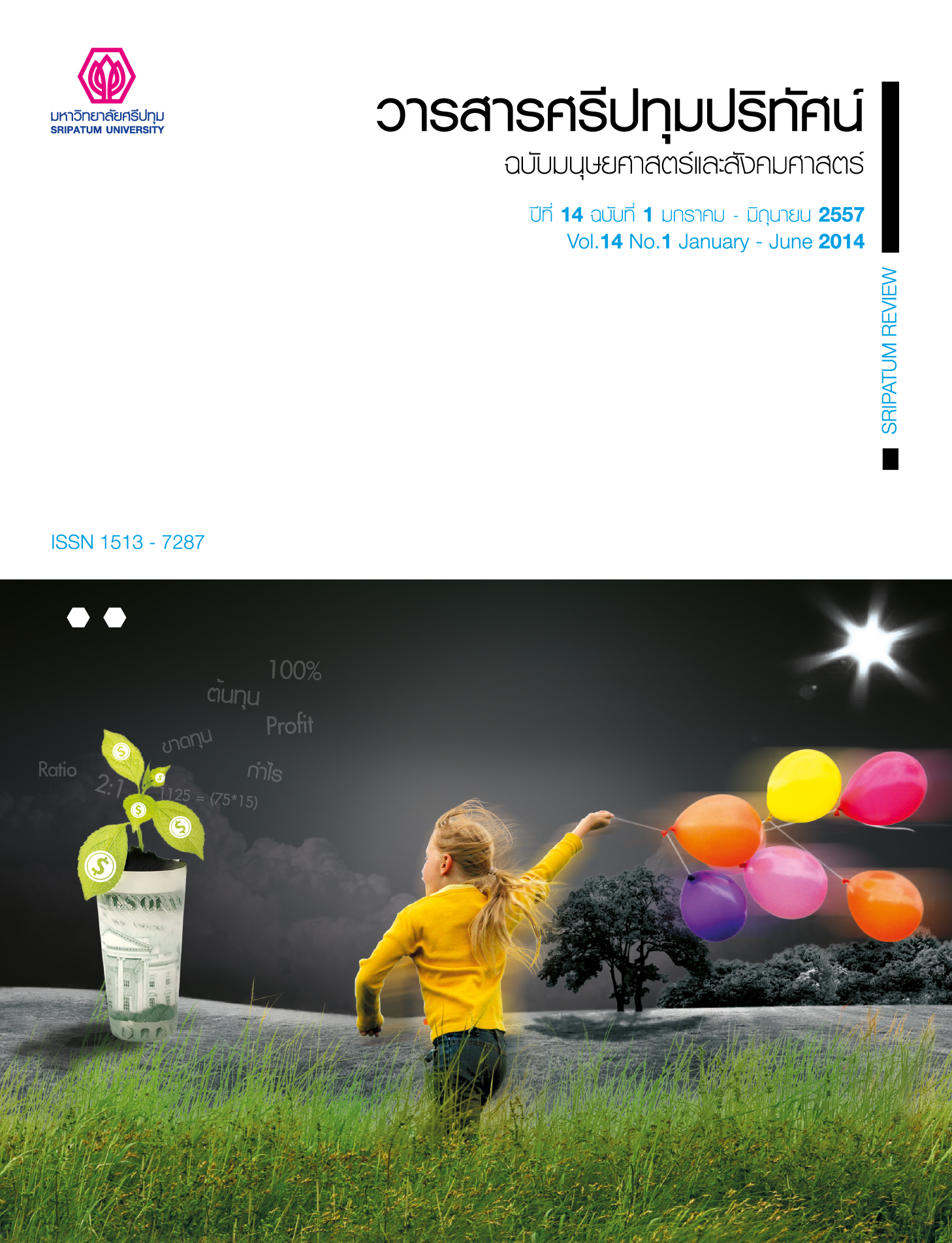THAI–TEOCHEW CODE–SWITCHING FUNCTIONS IN THE SPEECH OF THE CHINESE THAI IN YAOWARAT COMMUNITY
Main Article Content
Abstract
This paper aims to study the Thai-Teochew code-switching of the Chinese Thai who can speak the two languages, and to verify its actual functions in a communication system. The data were collected from 20 Thai-Teochew Chinese bilingual speakers who are of the second generation and have been living in Yaowarat Community, or Bangkok’s Chinatown. The natural speech data were transcribed from the conversation between the subjects and a Thai-Teochew Chinese research assistant. The result suggests that there are six Thai-Teochew code-switching functions: quotation, addressee specification, interjection, reiteration, message qualification, and personalization of the message.
Article Details
1. กองบรรณาธิการสงวนสิทธิ์ในการพิจารณาและตัดสินการตีพิมพ์บทความในวารสาร
2. บทความทุกเรื่องจะได้รับการตรวจสอบทางวิชาการโดยผู้ทรงคุณวุฒิ แต่ข้อความและเนื้อหาในบทความที่ตีพิมพ์เป็นความรับผิดชอบของผู้เขียนแต่เพียงผู้เดียว มิใช่ความคิดเห็นและความรับผิดชอบของมหาวิทยาลัยศรีปทุม
3. การคัดลอกอ้างอิงต้องดำเนินการตามการปฏิบัติในหมู่นักวิชาการโดยทั่วไป และสอดคล้องกับกฎหมายที่เกี่ยวข้อง
References
ทวี วัดงาม. 2540. ถนนเก่าในเมืองกรุง.กรุงเทพ ฯ: บริษัทต้นอ้อ แกรมมี่ จำกัด.
ปราณี กายอรุณสุทธิ์. 2526. คำยืมภาษาจีนในภาษาไทยปัจจุบัน. วิทยานิพนธ์มหาบัณทิต. ภาควิชาภาษาศาสตร์ จุฬาลงกรณ์มหาวิทยาลัย.
ราชบัณฑิตยสถาน. 2553. พจนานุกรมศัพท์ ภาษาศาสตร์ (ภาษาศาสตร์ประยุกต์) ฉบับราชบัณฑิตยสถาน. กรุงเทพ ฯ:รุ่งศิลป์การพิมพ์.
เสี่ยว อานต้า. 2547. ไวยากรณ์จีน. กรุงเทพ ฯ: ทฤษฎี.
Apple, Rene and Muysken, Pierter. 1988. Language Contact and Bilingualism. London: Edward Arnold Division of Hodder & Stoughton.
Auer, Peter and di Luzio, Aldo (eds.). 1992.The Contextualization of Language. Amsterdam/ Philadelphia: John Benjamin Publishing Company.
Bateson, G. 1959. The Message: ‘This is play’. In Schaffner, B. (ed.), Group Processes (pp. 145-242). New York: Joshia Macy Jr. Foundation.
Boztepe, Erman. 2003. Issues in Code- Switching: Competing Theories and Models. In Working Papers in TESOL and Applied Linguistics. (vol. 3, 2 pp. 3).Teacher College: Columbia University.
Gumperz, John. 1977. The Sociolinguistic Significance of Conversational Code- switching. Working Papers of the Language Behavior Research Laboratory. University of California, Berkeley.
Gumperz, John. 1982. Discourse Strategies. Cambridge: Cambridge University Press.
Kachru, B. B. 1983. On Mixing. In B. Kachru (ed.), The Indianization of English: The English Language in India (pp. 193-207). New Delhi: Oxford University Press.
Milroy, Lesley and Pieter, Muysken (eds.). 1995. One Speaker, Two Languages: Cross-disciplinary Perspectives on Code-Switching. Cambridge: Cambridge University Press.
Muysken, Pieter. 2011. Code-Switching. In Mesthrie, Rajend (ed.), The Cambridge Handbook of Sociolinguistics (pp. 301). Cambridge: Cambridge University Press.
Myers-Scotton, Carol. 1993b. Social Motivations for Codeswitching: Evidence from Africa. Oxford: Clarendon Press.
Poplack, Shana. 1980. Sometime I’ll start a Sentence in English y termino en español: Toward a Typology of Code-Switching. Linguistics (vol. 18, 7/8 pp. 581-618).
Ritchie, William C. and Bhatia, Tej K. 2006. Social and psychological factors in language mixing. In Tej K. Bhatia and William C. Ritchie (eds.), The Handbook of Bilingualism (pp. 336-352). Oxford: Blackwell.
Sankoff, D. and Poplack, S. 1981. A Formal Grammar for Code - Switching. International Journal of Human Communication (vol. 14 no. 1-4).
Singh, R. 1985. Grammatical Constraints on Code-Switching: Evidence from Hindi-English. Canadian Journal of Linguistics (vol. 30 pp. 33-45).
Sridhar, S. N. and Sridner, K. 1980. The Syntax and Psycholinguistics of Bilingual Code-Mixing. Canadian Journal of Linguistics (vol. 34 pp. 407-416).
Van Dulm, Ondene. 2007. The Grammar of English-Afrikanns Code-Switching: a Feature Checking Account. LOT, the Netherlands (pp. 9-39).


